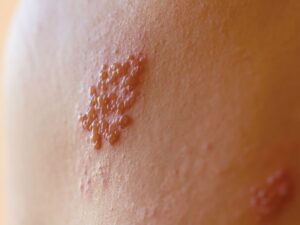Perhaps you’ve felt an itching and burning sensation in a specific area on your body. You think to yourself that it will go away, but then you notice that a rash has developed in that same area, and it’s slightly painful. The possibilities of what it might be quickly rush through your head. Poison ivy? An allergic reaction? To put the guesswork to bed, you schedule an appointment with your doctor who, after a thorough exam, reveals your itching, burning, and pain is in fact shingles.
One of the biggest misconceptions about shingles is that it is just like chickenpox. While there are similarities, there are some major differences between the two viruses.
Shingles and chickenpox are caused by the same virus (varicella-zoster virus), but they are different. Dr. Courtney James with Our Lady of the Lake Children’s Health Pediatrics at Zachary says, “Chickenpox is usually characterized by a more widespread blistering rash to the body and not localized, as in shingles.” Another very important distinction between shingles and chickenpox is who can contract them.
Dr. Ann Logarbo says, “Shingles is not a pediatric illness. It is a reactivation of the chickenpox virus in the spinal cord.” This means that if you have shingles, your children are not at risk for shingles. However, if they have not been vaccinated, they could get chickenpox.
So, how can you help your children stay safe? Dr. James advises, “Precaution should be taken to prevent spread of the virus. Keep the area covered, if possible, and wash your hands if the area is touched. To prevent the chickenpox infection, children should receive the vaccination.”
One of the best defense mechanisms to keep your kiddos safe from the virus is by making sure they have all of their vaccinations up to date, and by keeping yourself safe (hands cleaned and the area covered!) should you contract shingles. And worry not, in 7-10 days, your rash should heal over, and you’ll be right as rain soon after.





